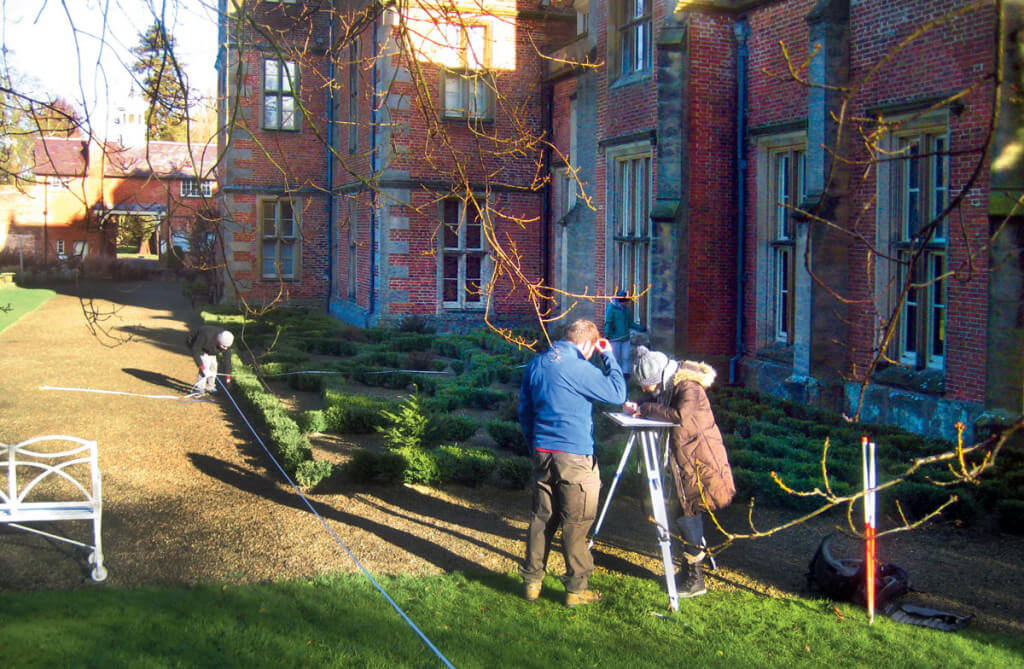- February 06, 2014
- By Karen Shih ’09
If you’re looking for the University of Maryland’s oldest landmark, you won’t find it nearby at Morrill Hall or the Rossborough Inn—or even at Riversdale Mansion, former home to the university’s founder. Instead, you’ll have to cross the Atlantic and travel the winding roads of the northern English countryside, past grazing lambs and ruined abbeys, to a 17th century estate.
Kiplin Hall, a magnificent country home, is the ancestral seat of the powerful Calvert family that founded not just the university, but also the state of Maryland.
In 1987, a UMD professor brought a group of students to the hall for the first time, reconnecting the university with its founding family. Since then, hundreds of other Terps have arrived to study its unique architecture and help improve the estate, Maryland’s version of Downton Abbey.
The Calvert Legacy
George Calvert, the first Lord Baltimore, was a Catholic who never quite fit in in Protestant England, and the hunting lodge he had built on 800 acres near his childhood home reflected his individuality.

The three-story house was constructed of red brick, rather than traditional Yorkshire sandstone. Its four towers were arranged in the middle of each wall, instead of at the corners, giving the building from a bird’s-eye view the sense of having a cross through it.
The house, built in the 1620s, was a testament to the influence he’d gained at the English royal court. Calvert came from modest means, but his gift for languages caught the eye of James I, who named him secretary of state.
While at court, Calvert had to convert to Anglicanism. But in 1624, he reaffirmed his Catholic faith and resigned. James I, to reward his years of loyalty, bestowed on him his title.
Calvert turned his eye to the New World, hoping to create a colony for religious freedom, as well as to discover new economic opportunities.
After a failed attempt in Newfoundland, he looked to the rich tobacco fields of Virginia, just north of the Potomac River. Calvert died just before Charles I granted the charter, but his son, Cecil, was able to realize his dream. The Ark and The Dove, carrying about 200 settlers, landed in Maryland in 1634. Leonard, Cecil’s younger brother, became Maryland’s first governor.
Two centuries later, their descendant Charles Benedict Calvert provided the vision and the land to create what became UMD. In 1851, he proposed a plan for the Maryland Agricultural College, and he sold the college his 428-acre Rossborough Farm, part of his vast Riversdale estate, to serve as its home.
Reviving Kiplin
For years, students from the School of Architecture, Planning and Preservation painted, sawed and hammered each summer at the Chalfonte Hotel in the seaside resort of Cape May, N.J. Guided by architecture Professor David Fogle, they helped the oldest continuously operating hotel in the city—in business since 1867—maintain its Victorian charm.
Their efforts, documented in a 1985 newspaper article, caught the eye of wealthy business owner Leonard Crewe, president of the Maryland Historical Society and a Kiplin Hall trustee. He had a proposition: Take your work to England.

Kiplin Hall had been in steady decline over most of the last century. Its heyday was in the 1800s, when tenants farmed the 5,000 acres surrounding the house and provided the family with a comfortable living. But in the early 1900s, as the aristocracy lost its grip on power and money (much like the Crawley family on the PBS show), many moved to London and abandoned their expensive country estates. One of Kiplin’s last owners sold off most of the land and the valuable Italian art inside. The last blow came during World War II, when the Royal Air Force and army requisitioned the property for its troops. Bridget Talbot, the house’s final owner, tried—with only partial success—to stop them from using paintings for target practice and destroying furniture for kindling.
Though unable to keep up with Kiplin’s maintenance, Talbot fended off its demolition in 1953. She tried to interest environmental, educational and social welfare organizations in using it, advertised it as a conference center and even traveled to Maryland to plead for financial help.
Talbot died in 1971, leaving the house in the hands of the Kiplin Hall Trust. The trustees reached out to Crewe, who had first visited in the late 1960s, to see if he could help. In 1975 he arranged funding for its new roof, a crucial step in giving the house any chance of survival.
But when Fogle and his students arrived in Yorkshire in the summer of 1987, it was apparent the house needed much more. Jim Shetler M. Arch. ’91 was in that first group.
“The main rooms were maintained, but half the place was a mess,” he says. “There were rooms with furniture piled up, wallpaper falling down and stuff everywhere.”
They focused on two rooms on the top floor, ripping out a bathroom and painting and repairing walls, trim and plaster. But they soon discovered mold had virtually taken over the house, so to avoid risking their health, the students stopped working in the main hall.
(It should have been off-limits to them in the first place: Since 1953, Kiplin Hall had been designated a “Grade 1” building by English Heritage, the British agency that oversees historic buildings, meaning only architects and contractors from an approved list were allowed to work on the house.)
Instead, the students turned their attention to the former stables, where they replaced windows and put down slate floor, carrying out part of a design by an architect hired by the estate’s trustees. It became the Maryland Study Centre at Kiplin Hall, supported in part by the Maryland Foundation for Kiplin Hall and the state. It now includes a kitchen, several bathrooms and room for up to 20 students. Maryland students have returned there every year since.
The Upper Drawing Room served as a sitting room for Royal Air Force officers during World War II. It includes portraits of Bridget Talbot's father and brother, a mid-19th century painting of the hall as viewed from the south, and Arts and Crafts cabinets designed by Walter Carpenter's wife, Beatrice. Photo courtesy of Kiplin Hall.

“When our students go to Paris and Rome, where they stay and what they look at applies to hundreds of universities over the ages,” says Fogle, now a professor emeritus. “But this was absolutely unique… It’s a connection that doesn’t exist anywhere else.”
The Hall Restored
Kiplin’s restoration limped along for years, relying on local volunteers and piecemeal donations. But in the early 1990s, a large gravel deposit was discovered on the property—and England had just started expanding a major north-south highway.
The quarry provided the revenues needed to ramp up the restoration. In 2001, after a decade of work, Kiplin Hall reclaimed its former glory and officially opened to the public. Today, Kiplin offers tours and activities primarily from April through October. The 16,000-square-foot house contains more than 200 paintings throughout its 19 rooms, 15 of which are open for viewing. They recall each era of its ownership, including a Gothic-style library and a room that’s been left as it was during World War II.
 An upstairs room illuminates Kiplin’s Maryland connection for visitors. Katie Irwin ’99, M. Arch. ’01 and her classmates created the exhibit in the summer of 1997.
An upstairs room illuminates Kiplin’s Maryland connection for visitors. Katie Irwin ’99, M. Arch. ’01 and her classmates created the exhibit in the summer of 1997.
“Being there definitely strengthened my love of historic buildings and architecture,” says Irwin, who has since restored many ambassadors’ residences in Washington, D.C.
Living, Learning, Designing
Hundreds of Maryland students have spent summers at Kiplin, learning about the architecture and history of the idyllic estate and the surrounding area.
But bustling summers always turned into quiet falls and winters, which didn’t seem right to architecture Professor Emeritus Karl Du Puy.
“If you come for three weeks, you’re not taking advantage of the estate,” says Du Puy, who led many summer programs. “If you come for a whole semester, the students can live here and really be removed from all the comings and going of the real world and lose themselves in a beautiful place.”
He created a semester-long program in 2010 in which around 10 undergraduate and graduate students live, learn and design at the center each spring. Students have presented proposals to the trustees for a new visitor center, enhancements to garden areas and the repurposing of outbuildings, and their ideas have been incorporated into projects throughout the estate.
“There’s a lot of work left to be done on the grounds at Kiplin,” says Jeff McInturff M. Arch. ’13, who went in 2012. “Living there when you’re designing something, you can go out five times a day and measure and take photos.”
He stills refers to those photos and drawings in his work, even though he focuses on contemporary design.
“Going to Kiplin was such an unbelievable opportunity,” he says. “It takes you a while to know how much you’ve learned.” TERP
